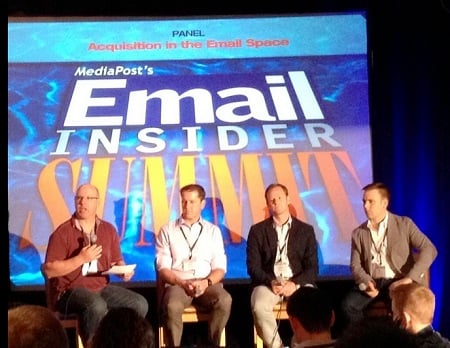 This week, I flew to beautiful Park City, UT, to attend MediaPost’s Email Insider Summit. It was a fantastic experience filled with rousing discussion, thought-provoking presentations and, of course, a little skiing.
This week, I flew to beautiful Park City, UT, to attend MediaPost’s Email Insider Summit. It was a fantastic experience filled with rousing discussion, thought-provoking presentations and, of course, a little skiing.
On Tuesday, I was fortunate enough to lead a panel on a topic I, and the rest of the TowerData team, have been exploring more in depth over the past several months: how do companies appropriately manage email frequency? How do we, as marketers, achieve a healthy balance that keeps customers engaged while driving down unsubscribe rates and spam complaints?
The panel, composed of Jeff Carl (Angie’s List), Sarah Lessem (Aon), Omer Navaid (Cars.com) and Shanon Strahl (Zoro), offered insight into their own practices and we discovered three valuable points.
1. Frequency Depends on Your Company Type and Product
When I say “company type,” I’m not just referring to whether your business is B2B or B2C, although this is a key component in developing your frequency. The number of messages you send your subscribers depends greatly on your industry, your business model and your product. All of these factors play into the buying cycle, which directly impacts when and how often customers expect (and want) communication.
For example, as Omer pointed out, there is a clear cycle for car buyers. Generally they make their purchase within a certain window, but are not interested in making another purchase for multiple years. Jeff finds people are less interested in finding a contractor in the few weeks after hiring someone for a home service. Sarah uses a monthly cadence to provide “sticky” content that resonates with her prospects. Shannon looks at engagement metrics to adjust her frequency and sends fewer emails to less engaged subscribers.
2. Take Stock of Action-Based Emails
First your customer receives your monthly newsletter, a few hours later they receive a promotional offer. After visiting your site, this customer receives a retargeting email and, later in the day, a cart abandonment notice. Your prospect has now received four emails from your company, and they haven’t even had lunch.
While you shouldn’t stop customers from receiving relevant action-based emails just because they happen to abandon their cart on the same day you send your monthly newsletter, you should be sure to set clear expectations. Allow customers to control the flow. Clearly set expectations as customers sign up, and allow your subscribers to choose which types of communications they do (and don’t) want to receive.
3. Test, Test and Test Again
Like any aspect of marketing, your email strategy is nothing without plenty of testing. All four panelists said they regularly review campaign analytics and look for trends to determine their company’s frequency “sweet spot.”
Because there is no one-size-fits-all solution, it’s imperative for you to determine which email metrics are most important and review them regularly. You may discover reducing a drip campaign from 6 to 4 emails reduces the unsubscribe rate by more than 10 percent. Or, you may discover sending short, weekly updates results in higher click rates than denser monthly newsletters.
If this panel has proven anything, it’s that there is no one answer to the question of the perfect frequency. However, today’s marketers have access to a virtual arsenal of tools to help us determine what works best, and obtain all the data we need to drive future strategies.
Ready to segment your lists like a pro? First you need access to the right data. Learn how to personalize and segment your database with TowerData Email Intelligence.
 Affiliate Marketing
Affiliate Marketing Automotive
Automotive eCommerce and Retail
eCommerce and Retail FinTech
FinTech LeadGen
LeadGen Nonprofit and Political
Nonprofit and Political Payments
Payments Technology Platforms
Technology Platforms Tourism and Hospitality
Tourism and Hospitality
 This week, I flew to beautiful Park City, UT, to attend
This week, I flew to beautiful Park City, UT, to attend 